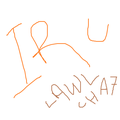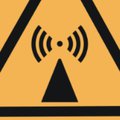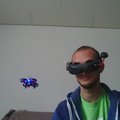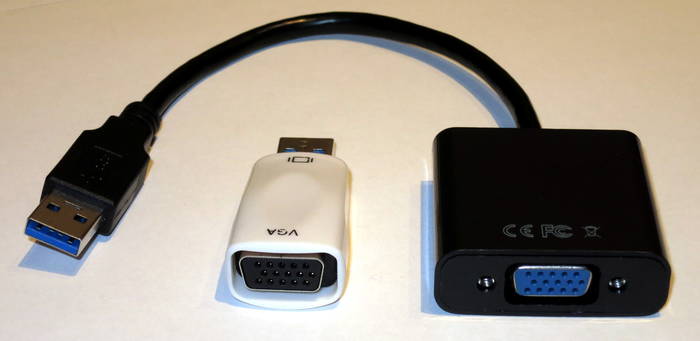 OK, everyone, it's noon here in the Pacific time zone, so let's get started. Today we have @Signals Everywhere/KR0SIV to talk about software-defined radio, which I can't believe we've never done a Hack Chat about.
OK, everyone, it's noon here in the Pacific time zone, so let's get started. Today we have @Signals Everywhere/KR0SIV to talk about software-defined radio, which I can't believe we've never done a Hack Chat about.
@Signals Everywhere/KR0SIV - Welcome! Can you kick us off with a little about yourself and how you discovered SDR?
 Sure thing @Dan Maloney
Sure thing @Dan Maloney
So my name is Harold Giddings although most online know me as Corrosive or my amateur callsign KR0SIV
I originally got involved with SDR when the RTL drivers were originally modified from old TV Tuners to an SDR platform.
This was years ago when I was still active on IRC and once I saw these things in action. I was officially addicted
 I'm currently employed as a commercial radio technician and so thankfully I get to have radio fun most days even when I'm not playing with an SDR (which I still find excuses to use at work)
I'm currently employed as a commercial radio technician and so thankfully I get to have radio fun most days even when I'm not playing with an SDR (which I still find excuses to use at work)
 What SDRs are you using now, and what software do you use?
What SDRs are you using now, and what software do you use?
 Software Defined Radio is really what got me back into radio. I take my amateur exam shortly after getting into SDR.
Software Defined Radio is really what got me back into radio. I take my amateur exam shortly after getting into SDR.
It was like opening an entirely new world being able to look at the radio spectrum via the waterfall rather than scanning individual channels.
 [Arsenijs] should work now (ignore this message)
[Arsenijs] should work now (ignore this message)
 @RichardCollins Currently my primary daily drive is still the RTL-SDRv3 from the https://rtl-sdr.com blog however I have a large plethora of SDRs these days. My favorite SDR client software would have to be SDR# however, I make often use of CubicSDR and SDRConsole as well as when transmitting... SDRAngel
@RichardCollins Currently my primary daily drive is still the RTL-SDRv3 from the https://rtl-sdr.com blog however I have a large plethora of SDRs these days. My favorite SDR client software would have to be SDR# however, I make often use of CubicSDR and SDRConsole as well as when transmitting... SDRAngel
 Do you have particular "targets" or frequency ranges, or just browsing generally?
Do you have particular "targets" or frequency ranges, or just browsing generally?
 My primary SDR for transmit has to be the PlutoSDR because it was affordable, has a good housing on it and is of course full duplex
My primary SDR for transmit has to be the PlutoSDR because it was affordable, has a good housing on it and is of course full duplex
 Totally awesome the visual representations of what you first hear on the radio (or maybe other sensor stimuli too)... then see in other ways to identify, qualify and quantify.
Totally awesome the visual representations of what you first hear on the radio (or maybe other sensor stimuli too)... then see in other ways to identify, qualify and quantify.
 Frequency ranges really depend on what I'm doing. Generally I like to play around in the SW/HF bands as well as looking for digital stuff in the commercial end of the 440 MHz range as well as 800-1090 for P25/trunking/ and ADS-B
Frequency ranges really depend on what I'm doing. Generally I like to play around in the SW/HF bands as well as looking for digital stuff in the commercial end of the 440 MHz range as well as 800-1090 for P25/trunking/ and ADS-B
 I can't wait until lab-grade spectrum analyzers are as cheap as SDR dongles ;)
I can't wait until lab-grade spectrum analyzers are as cheap as SDR dongles ;)
 Satcom is also a big thing of mine so I'll often be playing in the L-Band around 1.5ghz
Satcom is also a big thing of mine so I'll often be playing in the L-Band around 1.5ghz
 Have you ever come across unencrypted 'sensitive' data? If so, how did you handle it?
Have you ever come across unencrypted 'sensitive' data? If so, how did you handle it?
 for satcomms do you need a dish, also what kind of data do you pick up from them?
for satcomms do you need a dish, also what kind of data do you pick up from them?
 The PlutoSDR hack looks nice, thanks for sharing that.
The PlutoSDR hack looks nice, thanks for sharing that.
 I'm keeping my setup simple and cheap by using RTL-SDR's... until I've decided to extend my knowledge and play around wide bandwidth Ka-Band satellite links that and bought LimeSDR (after getting WAF .. Wife Approval Factor. Now .. everyday I'm learning from Signals Everywhere community so I can dive deeper in RF "Hacking".
I'm keeping my setup simple and cheap by using RTL-SDR's... until I've decided to extend my knowledge and play around wide bandwidth Ka-Band satellite links that and bought LimeSDR (after getting WAF .. Wife Approval Factor. Now .. everyday I'm learning from Signals Everywhere community so I can dive deeper in RF "Hacking".
 @Joshua Conway I do sometimes come acrossed sensitive data.. The key is simply not sharing it, if I do a video that contains such data I'll blur it out (such as my decoding of a pager signal)
@Joshua Conway I do sometimes come acrossed sensitive data.. The key is simply not sharing it, if I do a video that contains such data I'll blur it out (such as my decoding of a pager signal)
 The SDRs are improving, but they still have issues with comparison between different actual devices. I have two SDR V3s and they give totally different results on the same antenna.
The SDRs are improving, but they still have issues with comparison between different actual devices. I have two SDR V3s and they give totally different results on the same antenna.
 @anfractuosity This depends on the satellite you are looking at, sometimes I'll be in L-Band looking at inmarsat or iridium, a dish can be helpful but a tuned panel antenna works fine. There are also UHF band satellites that have analog voice on them
@anfractuosity This depends on the satellite you are looking at, sometimes I'll be in L-Band looking at inmarsat or iridium, a dish can be helpful but a tuned panel antenna works fine. There are also UHF band satellites that have analog voice on them
 Generally a dish is needed for Ku band / C band and other SHF
Generally a dish is needed for Ku band / C band and other SHF
 @BSA Secure you can still do a lot with a typical RTL based SDR
@BSA Secure you can still do a lot with a typical RTL based SDR
 @Seth I recently found another oscilloscope plugin for SDR# that I haven't verified/tried yet that isn't the one from IN3IEX:
@Seth I recently found another oscilloscope plugin for SDR# that I haven't verified/tried yet that isn't the one from IN3IEX:
http://www.amfone.net/Amforum/index.php?topic=34858
https://qsl.net/e/ea1kr//sdr/rtlsdr/
 for example looking at Ku band
for example looking at Ku band
 You can use the LNB as a down converter, technically... that's what it is
You can use the LNB as a down converter, technically... that's what it is
 You just need an external bias-t to push voltage to it for power
You just need an external bias-t to push voltage to it for power
 @Joshua Conway, whenever you will take a look on something, you will see that you can find sensitive data. For example, military traffic is encrypted so you cannot (and shouldn't) put your hands on - but still you can notice that protocols allows you to e.g. count how many participants are on the channel - it means that by monitoring traffic you can count how many military / police units are in the area.
@Joshua Conway, whenever you will take a look on something, you will see that you can find sensitive data. For example, military traffic is encrypted so you cannot (and shouldn't) put your hands on - but still you can notice that protocols allows you to e.g. count how many participants are on the channel - it means that by monitoring traffic you can count how many military / police units are in the area.
 @Seth et.al. this reference to SDRSharper doing a Google search from a Twitter post to find the above links and will try when I get the time:
@Seth et.al. this reference to SDRSharper doing a Google search from a Twitter post to find the above links and will try when I get the time:
 @RichardCollins I'm curious what kind of differences you are seeing
@RichardCollins I'm curious what kind of differences you are seeing
 @Signals Everywhere/KR0SIV Do you have any experience with radio astronomy using SDRs?
@Signals Everywhere/KR0SIV Do you have any experience with radio astronomy using SDRs?
 Thanks @James Finch ! I'll check that out!
Thanks @James Finch ! I'll check that out!
 @Chris Capobianco I've not yet delved into radio astronomy yet although I know you can detect the Suns radiation with a typical Ku LNB, it's something I want to get into but am currently limited in places I can set up a dish
@Chris Capobianco I've not yet delved into radio astronomy yet although I know you can detect the Suns radiation with a typical Ku LNB, it's something I want to get into but am currently limited in places I can set up a dish
 cheers @Signals Everywhere/KR0SIV , the data from irdium/immarsat is digital then? what kind of software do you use to decode that data?
cheers @Signals Everywhere/KR0SIV , the data from irdium/immarsat is digital then? what kind of software do you use to decode that data?
 @Signals Everywhere/KR0SIV Same here. Thanks for the information.
@Signals Everywhere/KR0SIV Same here. Thanks for the information.
 Hello to everybody, Anybody here has experience on electric utility remote telemetry unit signal decoding on 450MHz with RTL-SDR?
Hello to everybody, Anybody here has experience on electric utility remote telemetry unit signal decoding on 450MHz with RTL-SDR?
 @Seth et.al. Right, very welcome. This was interesting finding also in that same search as I've been wondering and thinking can so, something I've wanted to try with my TDS-520 test bed frankenscope either directly or with a pan adapter in some way:
@Seth et.al. Right, very welcome. This was interesting finding also in that same search as I've been wondering and thinking can so, something I've wanted to try with my TDS-520 test bed frankenscope either directly or with a pan adapter in some way:
https://www.rtl-sdr.com/gr-oscilloscope-using-an-oscilloscope-as-a-software-defined-radio/
 @anfractuosity Inmarsat is pretty straight forward, you can use USB in SDR# (or whatever) and pipe that audio using virtual audio cables into various applications for decoding. I have a video on this here:
@anfractuosity Inmarsat is pretty straight forward, you can use USB in SDR# (or whatever) and pipe that audio using virtual audio cables into various applications for decoding. I have a video on this here:
 cheers, will watch that!
cheers, will watch that!
 Iridium I generally don't recommend playing with as all the data contains are phone calls/text messages and other private information
Iridium I generally don't recommend playing with as all the data contains are phone calls/text messages and other private information
 Although, there is software for this too
Although, there is software for this too
 ahh
ahh
![]() @Signals Everywhere/KR0SIV are there any decent low-cost amateur SDR rigs -- the equivalent of the low-cost QRP rigs available from a number of sources?
@Signals Everywhere/KR0SIV are there any decent low-cost amateur SDR rigs -- the equivalent of the low-cost QRP rigs available from a number of sources?
 Inmarsat contains all kinds of data, some public such as emergency events and weather
Inmarsat contains all kinds of data, some public such as emergency events and weather
 some not so public like medical calls to aircraft
some not so public like medical calls to aircraft
 but for those you need to compile a voice codec which is easier said than done (but doable)
but for those you need to compile a voice codec which is easier said than done (but doable)
 I will send you a private message with some images. Generally the gains and frequency responses are different for the same software settings. I ran a five hour comparison last night over a 200 kHz region with one peak. The shifts across all frequencies are close to the same, but the individual signals are quite different. Part is the problem of synchronizing and comparing signals from the two devices. No timestamps in any of the data. No quantitative measures in SDR#. Sliders with no numbers.
I will send you a private message with some images. Generally the gains and frequency responses are different for the same software settings. I ran a five hour comparison last night over a 200 kHz region with one peak. The shifts across all frequencies are close to the same, but the individual signals are quite different. Part is the problem of synchronizing and comparing signals from the two devices. No timestamps in any of the data. No quantitative measures in SDR#. Sliders with no numbers.
 @Seth et.al. Spektrum is about the best I've used as a spectrum/signal analyzer with an RTL-SDR and there is the HackRF and SDRPlay ones also I haven't tried yet. Amazing there are even protocol analyzer like apps too.
@Seth et.al. Spektrum is about the best I've used as a spectrum/signal analyzer with an RTL-SDR and there is the HackRF and SDRPlay ones also I haven't tried yet. Amazing there are even protocol analyzer like apps too.
 @Curtis Franklin The only one's I've seen are the mcHF and it's clones
@Curtis Franklin The only one's I've seen are the mcHF and it's clones
 @Chris Capobianco I'm working on re-purposing Ka-band household hardware to be re-purposed for radio astronony. By using 30euros hardware you can receive (RX) Frequency 18.3 to 20.2 GHz which is still valid for radio astronomy,
@Chris Capobianco I'm working on re-purposing Ka-band household hardware to be re-purposed for radio astronony. By using 30euros hardware you can receive (RX) Frequency 18.3 to 20.2 GHz which is still valid for radio astronomy,
 Everyone, please add LINKs to mentions of specific software. These are HUGE internet topics. Narrow us down to a click. Thanks
Everyone, please add LINKs to mentions of specific software. These are HUGE internet topics. Narrow us down to a click. Thanks
 @RichardCollins Might be something that can be developed and validated in GRC?
@RichardCollins Might be something that can be developed and validated in GRC?
 and you can you RTL-SDR as its downcoverts to 300MHz - 800MHz
and you can you RTL-SDR as its downcoverts to 300MHz - 800MHz
 Yes, good idea. And keep in mind that there'll be a transcript available online after the Chat in case you want o refer to anything
Yes, good idea. And keep in mind that there'll be a transcript available online after the Chat in case you want o refer to anything
 Here are some of those decoders for inmarsat http://www.tekmanoid.com/egc.shtml http://www.inmarsatdecoder.com/ https://bitbucket.org/scytalec/
Here are some of those decoders for inmarsat http://www.tekmanoid.com/egc.shtml http://www.inmarsatdecoder.com/ https://bitbucket.org/scytalec/
![]() @Signals Everywhere/KR0SIV What's the least expensive SDR that could be built and deployed en masse?
@Signals Everywhere/KR0SIV What's the least expensive SDR that could be built and deployed en masse?
 @farmboy this is a difficult question, it depends on what features it needs
@farmboy this is a difficult question, it depends on what features it needs
 I generally say it's not about which SDR is best or the cheapest, it's about what SDR best fits what you want to do
I generally say it's not about which SDR is best or the cheapest, it's about what SDR best fits what you want to do
![]() 900 ISM, OOK / FSK. :)
900 ISM, OOK / FSK. :)
 @James Finch I do not know what GRC is? Can you provide a link? Thanks Happy to look at it.
@James Finch I do not know what GRC is? Can you provide a link? Thanks Happy to look at it.
 Then you'd be fine with even the bottom of the barrel RTL on eBay honestly @farmboy but I'd still recommend at least the RTL-SDR v3
Then you'd be fine with even the bottom of the barrel RTL on eBay honestly @farmboy but I'd still recommend at least the RTL-SDR v3
 GRC: https://wiki.gnuradio.org/index.php/GNURadioCompanion
GRC: https://wiki.gnuradio.org/index.php/GNURadioCompanion
Great Scott Gadgets GRC Tutorial: https://greatscottgadgets.com/sdr/
 @RichardCollins GRC is a format used by GNURadio https://www.gnuradio.org/
@RichardCollins GRC is a format used by GNURadio https://www.gnuradio.org/
![]() What's the top of the barrel?
What's the top of the barrel?

 I do have a basic comparison chat that's still a WiP https://signalseverywhere.com/sdr-comparison-chart/
I do have a basic comparison chat that's still a WiP https://signalseverywhere.com/sdr-comparison-chart/

 @Signals Everywhere/KR0SIV How do you transmit with a RTL-SDR? Are there other transmit/receive chipsets you would recommend? I am a Computer Engineer and have thought about prototyping my own.
@Signals Everywhere/KR0SIV How do you transmit with a RTL-SDR? Are there other transmit/receive chipsets you would recommend? I am a Computer Engineer and have thought about prototyping my own.
 @Sheridan-Tech You don't "technically" transmit with an RTL-SDR, there have been some that have managed to modulate data using a leaky LO but for a real transmit capable SDR I'd recommend the PlutoSDR at around $130 it's the cheapest SDR based option
@Sheridan-Tech You don't "technically" transmit with an RTL-SDR, there have been some that have managed to modulate data using a leaky LO but for a real transmit capable SDR I'd recommend the PlutoSDR at around $130 it's the cheapest SDR based option
 @RichardCollins Your welcome, I'm trying to find some references I made on reddit and FB regarding the windows installation of GRC since can be a, what reminds me of a Java app programming and program installation nuances, pain.
@RichardCollins Your welcome, I'm trying to find some references I made on reddit and FB regarding the windows installation of GRC since can be a, what reminds me of a Java app programming and program installation nuances, pain.
 There are also those cheap VGA adapaters that could be used to transmit cheaper
There are also those cheap VGA adapaters that could be used to transmit cheaper
 @Signals Everywhere/KR0SIV - Mind if I ask a little about your day job? What's new and exciting in public service radio these days? Everything is digital now I suppose.
@Signals Everywhere/KR0SIV - Mind if I ask a little about your day job? What's new and exciting in public service radio these days? Everything is digital now I suppose.

https://www.rtl-sdr.com/?s=vga
Search Results vga
Osmocom are some of the people behind the original discovery and development of the RTL-SDR (in particular Steve M), and today it looks like they have done it again by releasing exciting news of a way to turn a commodity $5 USB to VGA adapter into a TX-only capable SDR. They call their discovery 'osmo-fl2k', as the magic chip that makes it all happen is a Fresco Logic FL2000.
 What's your take on RPi 3 and Rpitx lib?
What's your take on RPi 3 and Rpitx lib?
![]() @Sheridan-Tech https://github.com/softerhardware/Hermes-Lite2/wiki/Group-Buy
@Sheridan-Tech https://github.com/softerhardware/Hermes-Lite2/wiki/Group-Buy
 @Sheridan-Tech What about RaspiTX ? You can transmit using FL2000 chip or raspberry pi .
@Sheridan-Tech What about RaspiTX ? You can transmit using FL2000 chip or raspberry pi .
 *Mind blown*
*Mind blown*
 @BSA Secure Can you provide a link to what you are doing? I tried to find you before to get specifics to try that but could not find enough info to reproduce what you did. I want to look up to 40 GHz, but downconverters for the 1-20 GHz seem to be available --- IF one can connect them to the SDR. It is not the money - it is the time to reproduce what someone else tried. Saving a few hundred dollars on hardware then spending three weeks to get it to working is false economics.
@BSA Secure Can you provide a link to what you are doing? I tried to find you before to get specifics to try that but could not find enough info to reproduce what you did. I want to look up to 40 GHz, but downconverters for the 1-20 GHz seem to be available --- IF one can connect them to the SDR. It is not the money - it is the time to reproduce what someone else tried. Saving a few hundred dollars on hardware then spending three weeks to get it to working is false economics.
 @Dan Maloney Most things are digital, most of the time our commercial customers get DMR Capacity Plus and Linked Capacity plus. Most of our police departments are on the state MARCS IP system which is Phase 1 P25
@Dan Maloney Most things are digital, most of the time our commercial customers get DMR Capacity Plus and Linked Capacity plus. Most of our police departments are on the state MARCS IP system which is Phase 1 P25
 After adding filters (I'm bothering @Signals Everywhere/KR0SIV to prepare simple how to build filters)
After adding filters (I'm bothering @Signals Everywhere/KR0SIV to prepare simple how to build filters)
 @Joshua Conway the RPITx library is great! I need to use it more, keeping in mind it's low power and very dirty... it's still great to learn and probably one of the cheapest methods to transmit
@Joshua Conway the RPITx library is great! I need to use it more, keeping in mind it's low power and very dirty... it's still great to learn and probably one of the cheapest methods to transmit
 Yes very correct @BSA Secure a filter should ALWAYS be used when transmitting anything that will go more than a couple feet
Yes very correct @BSA Secure a filter should ALWAYS be used when transmitting anything that will go more than a couple feet
 Thank you all. I was looking forward to this chat since it was posted. Now I have quite a bit to go on.
Thank you all. I was looking forward to this chat since it was posted. Now I have quite a bit to go on.
 You don't want to cause interference
You don't want to cause interference
 @RichardCollins et.al. I first started with this crude reference that didn't cause me any issues.
@RichardCollins et.al. I first started with this crude reference that didn't cause me any issues.
http://dewdetectionprojects.blogspot.com/2017/11/generic-procedure-for-installation-of.html
For Windows 10 I had issues... so wrote something up somewhere I guess like I was thinking on FB and Reddit...
 Yeah, not only digital but encrypted, or at least that's what I'm seeing. Used to avidly listen to local law enforcement on the state trunking system, but they encrypted everything last year. Bummer
Yeah, not only digital but encrypted, or at least that's what I'm seeing. Used to avidly listen to local law enforcement on the state trunking system, but they encrypted everything last year. Bummer
 There is no encryption in use for the most part in our state, generally this is because of the high cost to encrypt but also to public backlash about the fact that we should be able to "monitor the monitors" if you will.
There is no encryption in use for the most part in our state, generally this is because of the high cost to encrypt but also to public backlash about the fact that we should be able to "monitor the monitors" if you will.
 @BSA Secure I was planning on the 1.4 GHz range for neutral hydrogen, is there a LNB for that range?
@BSA Secure I was planning on the 1.4 GHz range for neutral hydrogen, is there a LNB for that range?
 I have a few RTL-SDRs set up at work and use it to monitor the system, it's funny because you can tell if someone i
I have a few RTL-SDRs set up at work and use it to monitor the system, it's funny because you can tell if someone i
 Dan Maloney
Dan Maloney
Discussions
Become a Hackaday.io Member
Create an account to leave a comment. Already have an account? Log In.